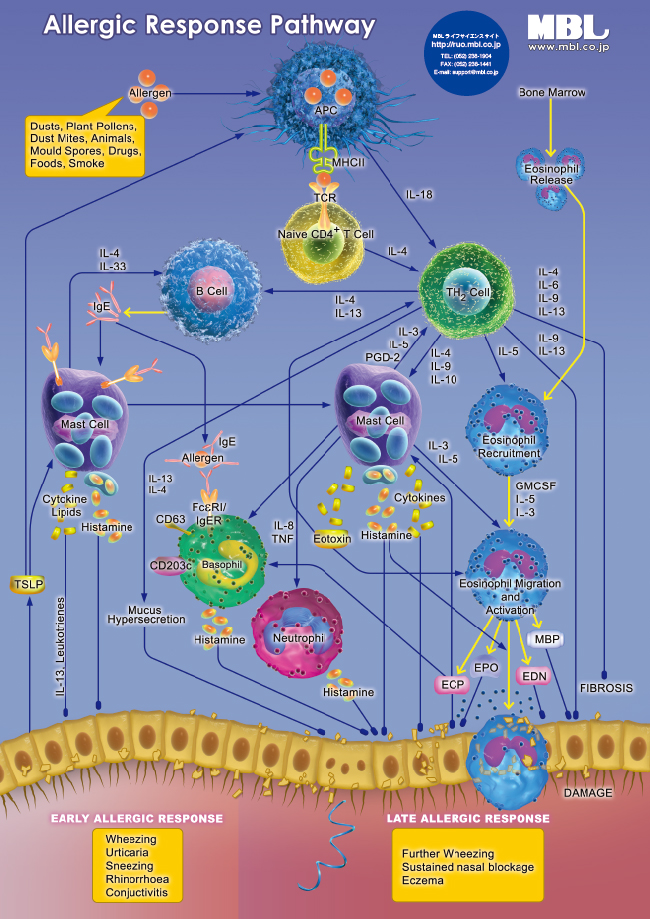Published by Deane Buckley on Mar 9, 2015 10:30:48 AM

Inflammation is regulated by small glycoproteins called cytokines. Cytokines are cell signaling proteins in the immune response pathway1. Il-18 is a cytokine that primarily facilitates Th1-type immunoreactions by acting on T cells.
Cytokines are produced by many of the major cell types involved in inflammation: dendritic cells, monocytes, macrophages, neutrophils and epithelial cells. Like many cytokines, Il-18 is first synthesized in an inactive form. Il-18 is activated by an enzyme called caspase-12.
Il-18 stimulates Th1 cells in the presence of an anti-CD3 antibody and triggers the production of Il-13 and IFN-γ. Il-13 plays a prominent role in the stimulation of B cell proliferation and immunoglobulin production. IFN-γ is involved in almost all phases of inflammatory and immune responses. Il-18 also acts on basophils and mast cells to cause complex physiological reactions such as an allergic response.
A major regulator of Il-18 is Il-18 binding protein3. In homeostasis, the amount of Il-18 binding protein exceeds that of Il-18. This prevents Il-18 from activating an inflammatory response. However, the body starts a caspase-1 activating pathway that increase the levels of caspase-1 and causes higher levels of Il-18 to be active. The increased levels of active Il-18 help generate an inflammatory response4.
Il-18 has been found to play a role in a variety of disease states. High levels of Il-18 have been found in the blood of patients with many different types of allergic diseases. These include bronchial asthma, atopic dermatitis and allergic rhinitis. Moreover, high levels of Il-18 have been found in patients with autoimmune diseases such as rheumatoid arthritis, systemic lupus erythematosus [SLE], adult Still’s disease, multiple sclerosis, Chrohn’s disease and ulcerative colitis. In many of these diseases such as adult Still's disease Il-18 is found to be at very high concentration levels5. Lastly, Il-18 appears to mediate the progression of type II diabetes6.
MBL International offers a wide variety of products to help in your study of Il-18. Major products include:
Citations:
1. Foster, John R. “The Functions of Cytokines and Their Uses in Toxicology.” International Journal of Experimental Pathology 82.3 (2001): 171–192. PMC . Web. 4 Feb. 2015.2. Dinarello C. A., Novick D., Kim S. & Kaplanski G. Interleukin-18 and IL-18 binding protein . Front. Immunol. 4 , 289 (2013).
3.Liang D, Ma W, et al., Imbalance of interleukin 18 and interleukin 18 binding protein in patients with lupus nephritis. Cell. Mol. Immunol., 3, 303-6 (2006), PMID: 16978540
4.Sekiyama A, Ueda H, Kashiwamura S, Sekiyama R, Takeda M, Rokutan K et al. A stress-induced, superoxide-mediated caspase-1 activation pathway causes plasma IL-18 upregulation. Immunity 2005; 22: 669–677.
5. Sugiura T, Kawaguchi Y, Harigai M, Terajima-Ichida H, Kitamura Y, Furuya T, et al. Association between adult-onset Still’s disease and interleukin-18 gene polymorphisms. Genes Immun. 2002;3(7):394–9.
6. Troseid M, Seljeflot I, et al., The role of interleukin-18 in the metabolic syndrome. Cardiovasc. Diabetol. 9, 11 (2010), PMID: 20331890
